350 Wild Horse Road, Lawrence, KS 66044, USA
Ted Harris
Please login or request access to view contact information.
The Aquatic Research Facility at the KU Field Station provides a physical platform for a broad range of field‐based research. Experimental ponds and tanks (mesocosms) function as surrogates of the natural environment and permit replication of treatments and controls. They allow rigorous tests of ecological relationships, which otherwise can be difficult to identify in natural settings.
Outdoor facilities: The Aquatic Research Facility was developed in stages over a 40-year period. It now is one of the largest aquatic research facilities in the U.S. and is used to address both basic and applied research questions.
Major components of the Aquatic Research Facility infrastructure include 100 experimental ponds ranging in size from 0.01 to 0.8 hectares; 77 ponds are 0.045 hectares, and 10 are 0.01 hectares. These ponds are filled/drained from the bottom, which allows ponds to function as experimental wetlands or lentic systems.
In addition, the facility has 80 large, 11‐cubic‐meter fiberglass tanks and a variety of enclosures that can be used for in situ experiments in any of the ponds. Experimental short flow through streams can also be constructed and used on site.
On a larger scale, Cross Reservoir (Surface area 3 hectares, 12 meters deep, 50-hectare watershed) serves as a model of small Midwestern reservoirs. Details on the biotic and abiotic conditions in Cross can be found in deNoyelles et al. 2016.
Experimental aquatic systems such as these effectively simulate lakes and reservoirs in central North America. Small ponds are a critical link between aquatic and terrestrial habitats because they often are the first type of aquatic habitat to receive nonpoint source pollutants.
Indoor facilities: A 325-square-meter greenhouse/mesocosm building, constructed in 2013, provides modern climate‐ controlled space that facilitates year‐round aquatic studies. A freestanding 110-square-meter aquatic research laboratory provides a space for sample preparation and analyses and is equipped with a flow-through water supply from the pond infrastructure. In addition, the Armitage Education Center has adjacent wet and dry laboratory facilities, a full kitchen, showers, laundry, classroom, and meeting space to accommodate up to 55 people. Two sleeping cabins are available to researchers for longer overnight stays.
Our outdoor and indoor facilities allow a multitude of parameters to be manipulated or controlled at varying scales. Water used in experiments is discarded to a series of catchment reservoirs on-site. Catchment reservoirs have long residence times, which allows for degradation of herbicides/pesticides/pharmaceuticals with relatively short half-lives.
Additionally, power is available at many of the ponds, allowing researchers to run large equipment within ponds/tanks for long time scales if needed.
Research topics have included:
- Cyanobacteria blooms and associated cyanotoxins
- Effects of herbicides, pesticides, and pharmaceutical products on algal, zooplankton, and fish communites
- Algal biofuels
- Environmental DNA fate and transport
- Ecological and biological stoichiometry
- Deep Chlorophyll Maxima (DCM) and algal migration
- Persistent pollutant degradation rates and processes
- Emergent insects
- Endangered species
- Fish competition and predation
- Trophic cascades/complex interactions
Effects of pollutants – nutrients, herbicides, pesticides, pharmaceuticals, and personal care products – on aquatic ecosystems and their complex interactions.
Equipment housed at the field station—tractors, mowers, loaders, water haulers, off-road vehicles, fire rigs (in case researchers wish to examine the response of aquatic systems to specific terrestrial/watershed fire regimes)—is used to implement and maintain research projects.
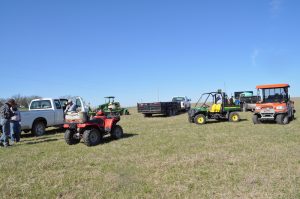
The Armitage Education Center at the KU Field Station has adjacent wet and dry laboratory facilities, a full kitchen, showers, laundry, and classroom and meeting space to accommodate up to 55 people. Two sleeping cabins are available to researchers for longer overnight stays.
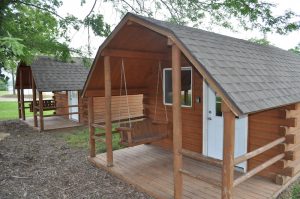
https://biosurvey.ku.edu/field-station/brochures
Publications:
|
Whittemore, D., and W.D. Kettle. 2016. Symposium overview: Ecology and climate change research at Kansas natural areas and field stations. Transactions of the Kansas Academy of Science 119:1-4. |
|
deNoyelles, F., Smith, V.H., Kastens, J.H., Bennett, L., Lomas, J., Knapp, C., Bergin, S., Dewey, S., Chapin, B., Graham, D. 2016. A 21-year record of vertically migrating subepilimnetic populations of Cryptomonas spp. Inland Waters 6: 173-184. |
|
Kettle, W.D. 2016. The University of Kansas Field Station: A platform for studying ecological and hydrological aspects of climate change. Transactions of the Kansas Academy of Science 119:12-20. |
|
Turner, C.R., K.L. Uy, and R.C. Everhart. 2014. Fish environmental DNA is more concentrated in aquatic sediments than surface water. Biological Conservation. 2014. http://dx.doi.org/10.1016/j.biocon.2014.11.017 |
|
Turner, C.R., D.J. Miller, K.J. Coyne, and J. Corush. 2014. Improved methods for capture, extraction, and quantitative assay of environmental DNA from Asian Bigheaded Carp (Hypophthalmichthys spp.) PLoS ONE 9(12): e114329. doi: 0.1371/journal.pone.0114329 |
|
Fortier, M-O.P., G.W. Roberts, S.M. Stagg-Williams, and B.S.M. Sturm. 2014. Life cycle assessment of bio-jet fuel from hydrothermal liquefaction of microalgae. Applied Energy 122:73–82. |
|
Bode, C., M. Criss, A. Ising, S. McCue, S. Ralph, S. Sharp, V. Smith, and B. Sturm. 2014. Pond power: How to use algae to energize inquiry and interdisciplinary connections. The Science Teacher 81(2). |
|
Smith, V.H. 2014. Progress in algae as a feedstock for bioproducts. Industrial Biotechnology 10(3):159-161. |
|
Cochran, F. V. and N. A. Brunsell. 2012. Temporal scales of tropospheric CO2, precipitation, and ecosystem responses in the central Great Plains. Remote Sensing of Environment 127: 316-328. |
|
Petrie, M. D. and N. A. Brunsell. 2012. The role of precipitation variability on the ecohydrology of grasslands. Ecohydrology doi:10.1002/eco.224, 5, 337-345. |
|
Knapp, C. W., W. Zhang, B. S. M. Sturm, D. W. Graham. Differential fate of erythromycin and beta-lactam resistance genes from swine lagoon waste under different aquatic conditions. Environmental Pollution. Volume 158, Issue 5, May 2010, 1506–1512. DOI: 10.1016/j.envpol.2009.12.020 |
|
Hanson, M.L., C.W. Knapp, and D.W. Graham. 2006. Field assessment of oxytetracycline exposure to the freshwater macrophytes Elodea dense (Pianch.) and Ceratophyllum demersum L. Environmental Pollution 141:434-442. |
|
Knapp, C.W., L.A. Cardoza, J. Hawes, E.M.H. Wellington, C.K. Larive, and D.W. Graham. 2005. Fate and effects of Enrofloxacin in aquatic systems under different light conditions. Environmental Science and Technology 39:9140-9146. |
|
Knapp, C.W., L. Lagadic, T. Caquet, M.L. Hanson, and D.W. Graham. 2005. Response of water column microbial communities to sudden exposure to Deltamethrin in aquatic mesocosms. FEMS Microbiological Ecology 54:157-165. |
|
Knapp, C.W. and D.W. Graham. 2004. Development of alternate ssu-rRNA probing strategies for characterizing aquatic microbial communities. Journal of Microbial Methods 56:323-330. |
|
Lennon, J.T., V. Smith, A. Dzialowski. 2003. Invasibility of plankton food webs along a trophic state gradient. Oikos 102:191-203. |
|
Ferrington, L.C., Jr. 2003. Studying intermittent streams. Ch. 4, pp. 46-64 in “Functions of Intermittent Streams: A Guidance Document for the Technical Information Workshop.” Proceedings, North American Benthological Society, Athens, GA, May 2003. |
|
Ensz, A.P., C.W. Knapp, and D.W. Graham. 2003. Influence of autochthonous dissolved organic carbon and nutrient limitation on alachlor biotransformation in aerobic aquatic systems. Environmental Science and Technology 37:4157-4162. |
|
Kettle, W., R. Hagen, J. deNoyelles, E. A. Martinko. 2001. The University of Kansas Field Station and Ecological Reserves: A Half Century of Research and Education. Kansas Biological Survey, Lawrence, KS Miscellaneous Publication Number 9:68 pp. — |
|
Graham, W.D., J. deNoyelles. 1995. The role of methanotrophic bacteria in aquatic bioremediation in a Kansas reservoir. Department of the Interior No. 3187:50 pp. |
|
Goldhammer,D.S., C.A. Wright, M.A. Blackwood, and L.C. Ferrington Jr. 1992. Composition and phenology of Chironomidae from the Nelson Environmental Study Area, University of Kansas. Netherlands Journal of Aquatic Ecology 26(2-4):281-291. |
|
Liechti, P., D. Huggins. 1991. Selected aquatic insects of the Kansas Ecological Reserves. Kansas Academy of Science Multidisciplinary Guidebook 4. Lawrence, KS:Kansas Geological Survey. — |
|
Kettle, W., D.O. Whittemore. 1991. Ecology and Hydrology of the Kansas Ecological Reserves and Baker Wetlands. Ecology and Hydrology of the Kansas Ecological Reserves and Baker Wetlands. Lawrence, KS:Kansas Geological Survey. 1-125. |
|
Kettle, W. 1991. Kansas Ecological Reserves–An overview. Ecology and Hydrology of the Kansas Ecological Reserves and Baker Wetlands. Lawrence, KS:Kansas Geological Survey. 20-22. — |
|
Wright, C.A., D.S. Goldhammer, M.A. Blackwood, and L.C. Ferrington Jr. 1991. Chironimids of the Nelson Environmental Study Area. In Ecology and Hydrology of the Kansas Ecological Reserves and the Baker University Wetlands, W.D. Kettle and D.O. Whittemore (eds.), KGS Open-File Report 91-35, pp. 98-102. |
|
Huggins, D.G. and M.L. Johnson. 1991. Ecological consequences of the control and elimination of macrophytes in small ponds by atrazine and grass carp. Proceedings from the Regional Lake Management Conference, Des Moines, IA, June 1991 pp. 124-148. |
|
Kettle, W.D. and D.O. Whittemore. 1991. Ecology and Hydrogeology of the Kansas Ecological Reserves and the Baker University Wetlands. Kansas Geological Survey Open-File Report 91-35. |
|
Whittemore, D.O. 1991. Hydrogeology of the natural areas. In Ecology and Hydrology of the Kansas Ecological Reserves and the Baker University Wetlands, W.D. Kettle and D.O. Whittemore (eds.), KGS Open-File Report 91-35, pp. 10-19. |
|
Kettle, W., J. deNoyelles. 1990. Determination of herbicide-induced alterations of aquatic habitats in Kansas. Department of the Interior No. 272:53 pp. |
|
Randtke, S.J., F. deNoyelles Jr., J.E. Denne, L.R. Hathaway, R.E. Miller, A.S. Melia, and C.E. Burkhead. 1988. Source control of THM precursors. In Proceedings of the Annual Conference of the American Water Works Association. 14-18 June 1988. Kansas City, MO, pp. 1545-1575. |
|
Randtke, S.J., F. deNoyelles Jr., C.E. Burkhead, R.E. Miller, J.E. Denne, L.R. Hathaway, and A.S. Melia. 1988. Trihalomethane precursors in Kansas water supplies: occurrence, source control measures, and impacts on drinking water treatment. In Proceedings of the Thirty-Eighth Annual Environmental Engineering Conference. 3 February 1988. University of Kansas, Lawrence, KS, pp. 47-89. |
|
Randtke, S.J., F. deNoyelles Jr., and C.E. Burkhead. 1987. Trihalomethane precursors in Kansas lakes: sources and control. Phase II. Contribution Number 266. Kansas Water Resources Research Institute, University of Kansas, Lawrence, KS, pp. 1-188. |
|
Hambright, K.D., R.J. Trebatoski, R.W. Drenner, W. Kettle. 1986. Experimental study of the impacts of bluegill (Lepomis macrochirus) and largemouth bass (Micropterus salmoides) on pond community structure. Canadian Journal of Fisheries and Aquatic Sciences 43(6):1171-1176. |
|
Dewey, S.L. 1986. Effects of the herbicide atrazine on aquatic insect community structure and emergence. Ecology 67(1):148-162. |
|
Randtke, S.J., F. deNoyelles Jr. and C.E. Burkhead. 1986. Trihalomethane precursors in Kansas lakes: sources and control (Report of year one results). Contribution Number 255. Kansas Water Resources Research Institute, University of Kansas, Lawrence, KS, pp. 1-114. |
|
Stay, F.S., D.P. Larsen, A. Katko, and C.M. Rohm. 1985. Effects of atrazine on community level responses in Taub microcosms. In T.P. Boyle, (ed.), Validation and Predictability of Laboratory Methods for Assessing the Fate and Effects of Contaminants in Aquatic Ecosystems. American Society for Testing and Materials, Philadelphia, PA, Special Technical Publication. |
|
Drenner, R.W., S.B. Taylor, X. Lazzaro, W. Kettle. 1984. Particle-grazing and plankton community impact of an omnivorous cichlid. Transactions of the American Fisheries Society 113:397-402. |
|
Riessen, H.P., W.J. O’Brien, and B. Loveless. 1984. An analysis of the components of Chaoborus predation on zooplankton and the calculation of relative prey vulnerabilities. Ecology 65(2):514-522. |
|
Wright, D.I. and W.J. O’Brien. 1984. The development and field test of a tactical model of the planktivorous feeding of white crappie (Pomoxis annularis). Ecological Monographs 54(1):65-98. |
|
Reinke, D.C. 1983. Algae collected by Rufus H. Thompson, II: Parallela novae-zelandiae, first report from North America. Technical Publications of the State Biological Survey of Kansas, University of Kansas 13:22-23. |
|
deNoyelles, J., W. Kettle. 1983. Site studies to determine the extent and potential impact of herbicide contamination in Kansas waters. Kansas Water Resources Research Institute Contribution No. 239:1-37. |
|
deNoyelles, J., W. Kettle, A.M. Kadoum. 1982. Plankton responses in experimental ponds to atrazine, the most heavily used pesticide in the United States. Environmental Protection Agency 14 pp. |
|
deNoyelles, J., W. Kettle. 1980. Experimental pond studies demonstrating the development of responses to a herbicide (atrazine) resulting from altered interactions among plankton species. Environmental Protection Agency 50 pp. |
|
Lei, C.H. and K.B. Armitage. 1980. Ecological energetics of a Daphnia ambigua population. Hydrobiologia 70:133-143. |
|
Lei, C.H. and K.B. Armitage. 1980. Energy budget of Daphnia ambigua Scourfield. Journal of Plankton Research 2(4):261-281. |
|
Lei, C.H. and K.B. Armitage. 1980. Growth, development and body size of field and laboratory populations of Daphnia ambigua. Oikos 35(1):31-48. |
|
deNoyelles, F. Jr. and W.D. Kettle. 1980. Herbicides in Kansas waters–evaluations of the effects of agricultural runoff and aquatic weed control on aquatic food chains. Contribution Number 219. Kansas Water Resources Research Institute, University of Kansas, Lawrence, KS, pp. 1-40. |
|
Lei, C.H. and K.B. Armitage. 1980. Population dynamics and production of Daphnia ambigua in a fish pond, Kansas. University of Kansas Science Bulletin 51(25):687-715. |
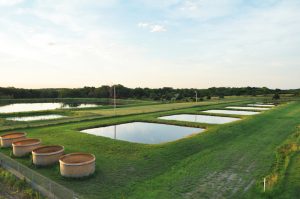 |
 |
 |
 |
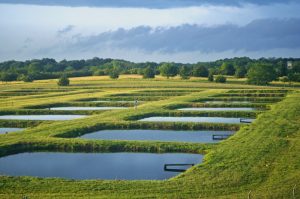 |
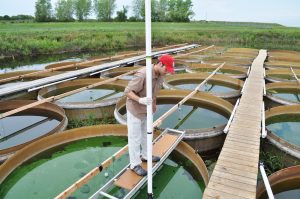 |
